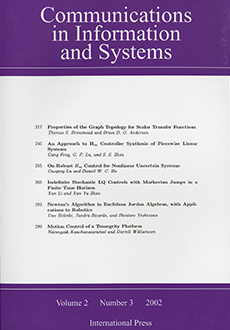Abstract
This paper is concerned with the maintenance of rigid formations of mobile autonomous agents. A key element in all future multi-agent systems will be the role of sensor and communication networks as an integral part of coordination. Network topologies are critically important for autonomous systems involving mobile underwater, ground and air vehicles and for sensor networks. This paper focuses on developing techniques and strategies for the analysis and design of sensor and network topologies required to achieve a rigid formation for cooperative tasks. Energy efficiency and communication bandwidth are critically important in formations of mobile autonomous agents, and hence strategies that make efficient use of power and energy are beneficial. Therefore, we develop topologies for providing sensing and communications with the minimum number of links, and propose methods requiring the minimum number of changes in the set of links in dynamic missions and maneuvers, including agent departure from a rigid formation, splitting a rigid formation and merging rigid sub-formations. To do this in a systematic manner, it is necessary to develop a framework for modeling agent formations that characterizes the sensing and communication links needed to maintain the formations. The challenge is that a comprehensive theory of such topologies of formations with sensing and communication limitations is in the earliest stage of development. Central to the development of these techniques and strategies will be the use of tools from rigidity theory, and graph theory.
Citation
Brian D. O. Anderson. Peter N. Belhumeur. Tolga Eren. A. Stephen Morse. Walter Whiteley. "Operations on Rigid Formations of Autonomous Agents." Commun. Inf. Syst. 3 (4) 223 - 258, 2003.
Information





